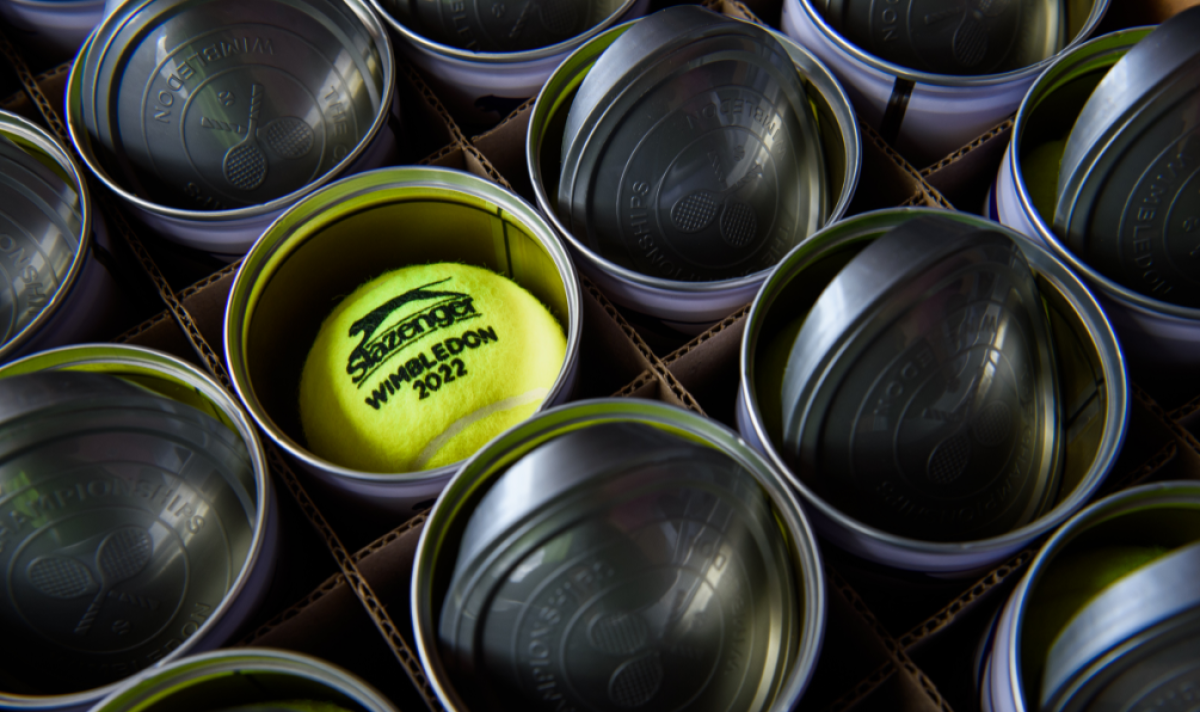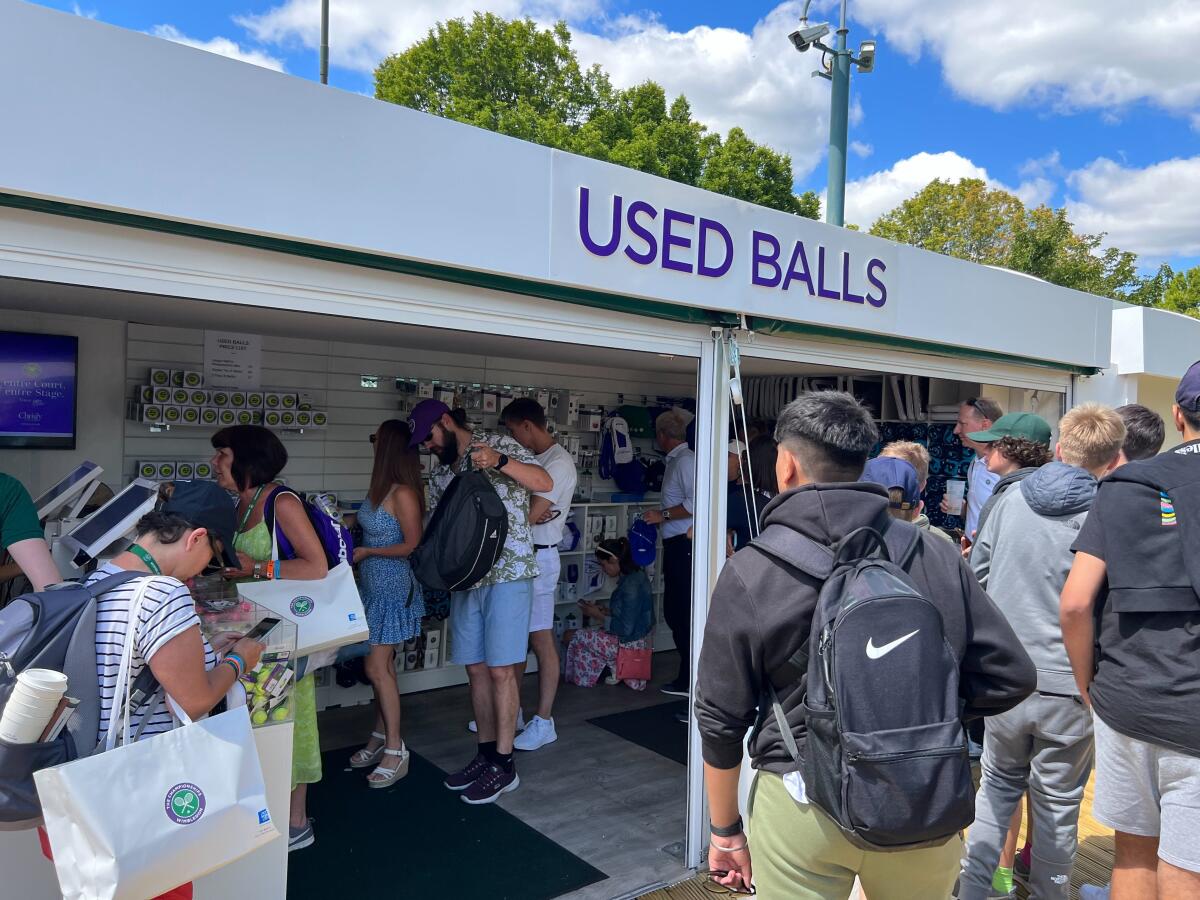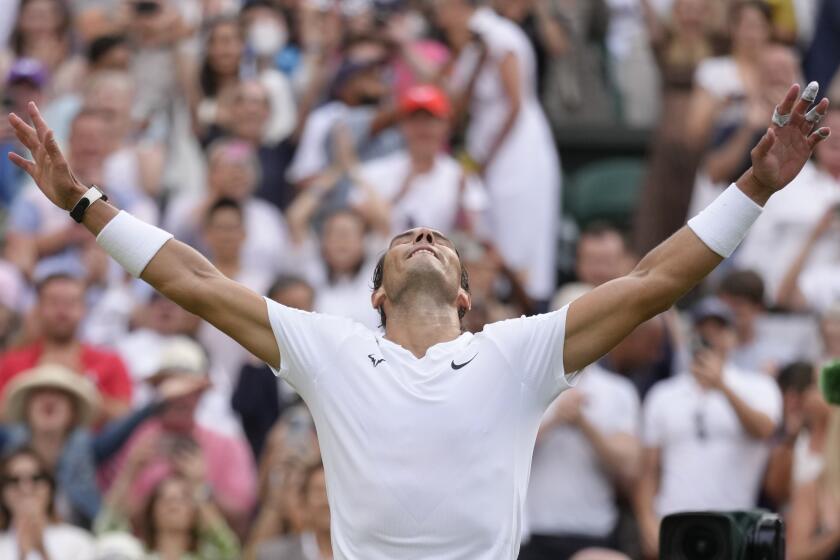‘You’re looking for a lack of fluff’: Why Wimbledon uses 55,000 tennis balls a year

- Share via
WIMBLEDON, England — So many elements of these glorious championships are ageless.
The tennis balls, however, age like a pitcher of cream in the sun.
Players here punish these optic yellow Slazengers with such ferocity that the balls have to be replaced several times per match.
The ball kids — boys and girls — only have six balls in circulation at any time during a match. There are three balls per can, and the first two cans are in play for the first warmup and seven games of a match. Thereafter, the balls are changed every nine games.
Over the course of two weeks, Wimbledon goes through 55,000 balls, including the 1,700 per day delivered to the practice courts in unopened cans.
“We have got a store that is absolutely rammed at the start of the tournament, and now even with a week left, it feels like all of the balls are gone,” said Andy Chevalier, Wimbledon’s ball distribution manager, who begins the storied event with 58,000 balls.
“So the first few days, we’re going through loads and loads. As we lose competitors, and as the matches get shorter because the juniors only play three sets instead of five, it looks like you’ve got hardly any balls left. But you do, you’re fine.”
John Isner and Nicolas Mahut tore through 42 cans of balls in 2010, when they played 183 games in a marathon match that lasted more than 11 hours spread over three days. With the recent addition of a champions tiebreak at the end of the final set, the most cans used in a five-set match is 18, and 10 in a three-set match.
The partnership between Slazenger and Wimbledon has been in place since 1902, making it the longest-running sponsorship in tennis, and perhaps in all of sports.
“The balls are so important, and they change,” said Pam Shriver, a five-time Wimbledon doubles champion. “They’re so different from the French Open to here to what they play with at the U.S. Open. No two tennis ball brands are exactly the same.”
One of the stars at Wimbledon each year is Rufus, the Harris’ hawk who scares pigeons away from the stadiums and grandstands.
Wilson provides the balls for the U.S. Open and French Open. Dunlop provides them for the Australian Open.
“You’re looking for a lack of fluff. If a ball is fluffed up, it’s a bigger ball. It’s going to go slower through the air.”
— Former Wimbledon champion Pat Cash
Manufacturers aside, balls that might appear identical to the unpracticed eye can have significant differences from a player’s perspective. That’s why players, and particularly the men, typically ask to be tossed three balls before serving, examine them closely, then pick one to stuff in a pocket and another to discard. (Frequently, women choose one of two.)
So what are the players looking for? What’s the difference between two balls that, from the stands, look the same?
“It doesn’t take long for the fuzz on a ball to get fluffy,” said Australia’s Pat Cash, who won a Wimbledon men’s singles title in 1987. “So you’re looking for a lack of fluff. If a ball is fluffed up, it’s a bigger ball. It’s going to go slower through the air. So if you’re serving, you want a ball that isn’t fluffed up, a new ball that goes through the air faster.”
But that isn’t always the case. It’s rare, but sometimes players want to pump the brakes on the speed and instead use, in Cash’s terms, a fluffier ball.
“I can remember when I was playing Andre Agassi, who would just pummel my serve every time,” said Patrick McEnroe, who like Shriver is now an ESPN analyst. “So I might actually look for a ball that was more fluffed up, because my serve was so bad that it couldn’t hurt him anyway. Maybe I’m looking for a way to not get as hurt by the way he blasted the return.”

Sometimes the ball decisions players make are based on superstition. If a player serves an ace, he or she might want that same ball back — Andy Murray is that way — and other players have a more systematic approach, one that doesn’t rely on what happened the previous point.
“I always rotated, so I could track which ball we just played with, and I would play with a different ball every time,” said nine-time Wimbledon winner Martina Navratilova, now an analyst for Tennis Channel. “I wanted the newest ball, so I was always trying to rotate them.”
Sometimes there’s gamesmanship involved. Consider the case of French player Richard Gasquet, who reached the semifinals at Wimbledon in 2007 and ’15.
Rafael Nadal kept his Grand Slam dream alive with a Wimbledon quarterfinal win over Taylor Fritz on Wednesday. Despite an abdominal injury, he advanced to play Nick Kyrgios.
“He would finish a point and the ball would end up on the other side, with the ball kid on the far side,” McEnroe said. “And he would make the ball kid throw the ball — which is very unusual, most players don’t do that.
“So some players would actually keep the ball to piss him off. They’d just take the ball and put it in their pocket, just knowing that he has to have the same ball.”
Located under the chair of every Wimbledon umpire are cans of balls referred to as 3s, 5s and 7s. Those are balls which have been used for approximately three, five or seven games. If a ball is hit into the crowd and needs to be replaced, the umpire will ask a ball kid for one of the balls in circulation then look to match it with a 3, 5 or 7 in similar condition.

And here’s the really cool part: Game-used balls that are retired from match play are delivered to a kiosk on the Wimbledon grounds and sold to fans at a reasonable price, with the proceeds going to charity — three pounds per ball ($3.57) in a presentation box, and four pounds ($4.76) for a can of three balls.
“I think it’s the best thing you can buy on the grounds,” Chevalier said. “It’s brilliant.”
The fluffier the better.
More to Read
Go beyond the scoreboard
Get the latest on L.A.'s teams in the daily Sports Report newsletter.
You may occasionally receive promotional content from the Los Angeles Times.













